check engine CITROEN C1 2021 User Guide
[x] Cancel search | Manufacturer: CITROEN, Model Year: 2021, Model line: C1, Model: CITROEN C1 2021Pages: 269, PDF Size: 7.63 MB
Page 150 of 269
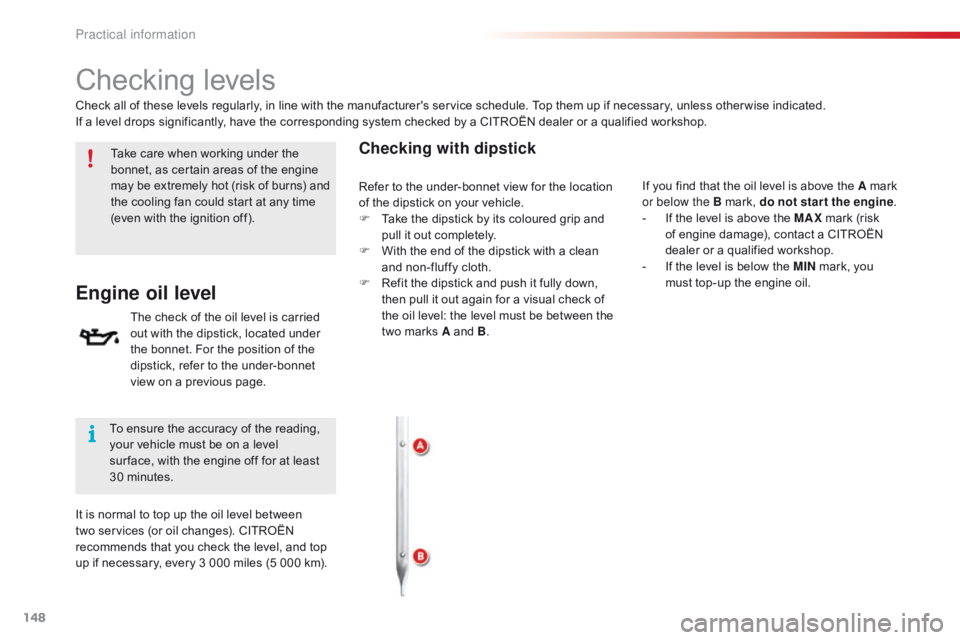
148
C1_en_Chap07_info-pratiques_ed01-2016
Checking levels
Take care when working under the bonnet, as certain areas of the engine
m
ay be extremely hot (risk of burns) and
t
he cooling fan could start at any time
(
even with the ignition off).
Engine oil level
The check of the oil level is carried out with the dipstick, located under
t
he bonnet. For the position of the
d
ipstick, refer to the under-bonnet
v
iew on a previous page.
Checking with dipstick
Check all of these levels regularly, in line with the manufacturer's service schedule. Top them up if necessary, unless other wise indicated.
I f a level drops significantly, have the corresponding system checked by a CITROËN dealer or a qualified workshop.
To
ensure the accuracy of the reading,
y
our vehicle must be on a level
s
ur face, with the engine off for at least
3
0 minutes.
It
is normal to top up the oil level between
t
wo services (or oil changes). CITROËN
r
ecommends that you check the level, and top
u
p if necessary, every 3 000 miles (5 000 km). If
you find that the oil level is above the A mark
o
r below the B mark, do not star t the engine.
-
I
f the level is above the MAX
mark (risk
o
f engine damage), contact a CITROËN
d
ealer or a qualified workshop.
-
I
f the level is below the MIN
mark, you
m
ust top-up the engine oil.
Refer
to the under-bonnet view for the location
o
f the dipstick on your vehicle.
F
T
ake the dipstick by its coloured grip and
p
ull it out completely.
F
W
ith the end of the dipstick with a clean
a
nd non-fluffy cloth.
F
R
efit the dipstick and push it fully down,
t
hen pull it out again for a visual check of
t
he oil level: the level must be between the
t
wo marks A and B.
Practical information
Page 151 of 269
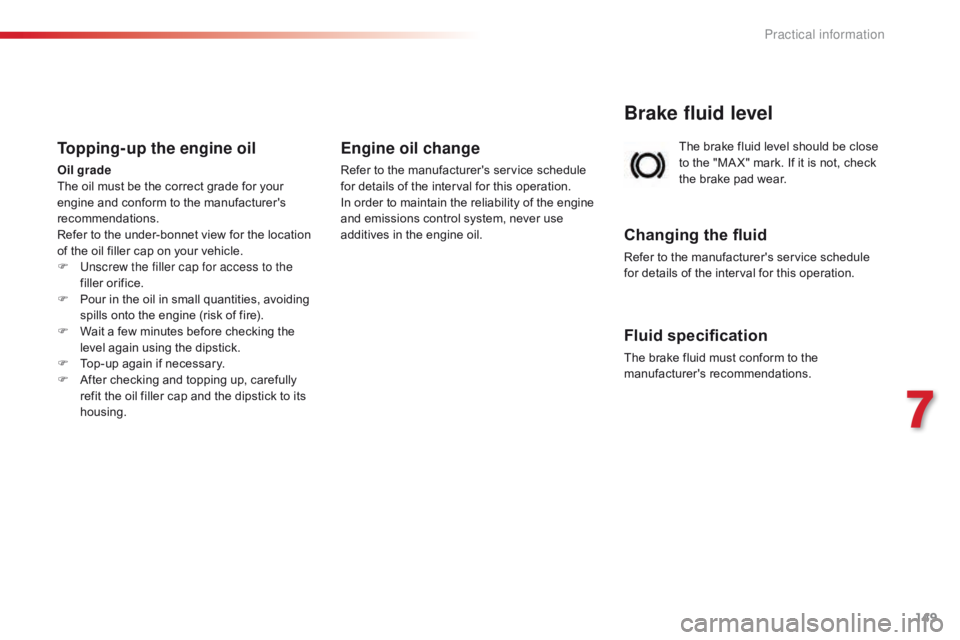
149
C1_en_Chap07_info-pratiques_ed01-2016
The brake fluid level should be close to the "MA X" mark. If it is not, check
t
he brake pad wear.
Brake fluid level
Changing the fluid
Refer to the manufacturer's service schedule for details of the interval for this operation.
Fluid specification
The brake fluid must conform to the manufacturer's r ecommendations.
Topping-up the engine oil
Oil grade
The oil must be the correct grade for your
e
ngine and conform to the manufacturer's
r
ecommendations.
Refer
to the under-bonnet view for the location
o
f the oil filler cap on your vehicle.
F
U
nscrew the filler cap for access to the
filler
orifice.
F
P
our in the oil in small quantities, avoiding
s
pills onto the engine (risk of fire).
F
W
ait a few minutes before checking the
l
evel again using the dipstick.
F
T
op-up again if necessary.
F
A
fter checking and topping up, carefully
r
efit the oil filler cap and the dipstick to its
h
ousing.
Engine oil change
Refer to the manufacturer's service schedule for details of the interval for this operation.
In
order to maintain the reliability of the engine
a
nd emissions control system, never use
a
dditives in the engine oil.
7
Practical information
Page 153 of 269
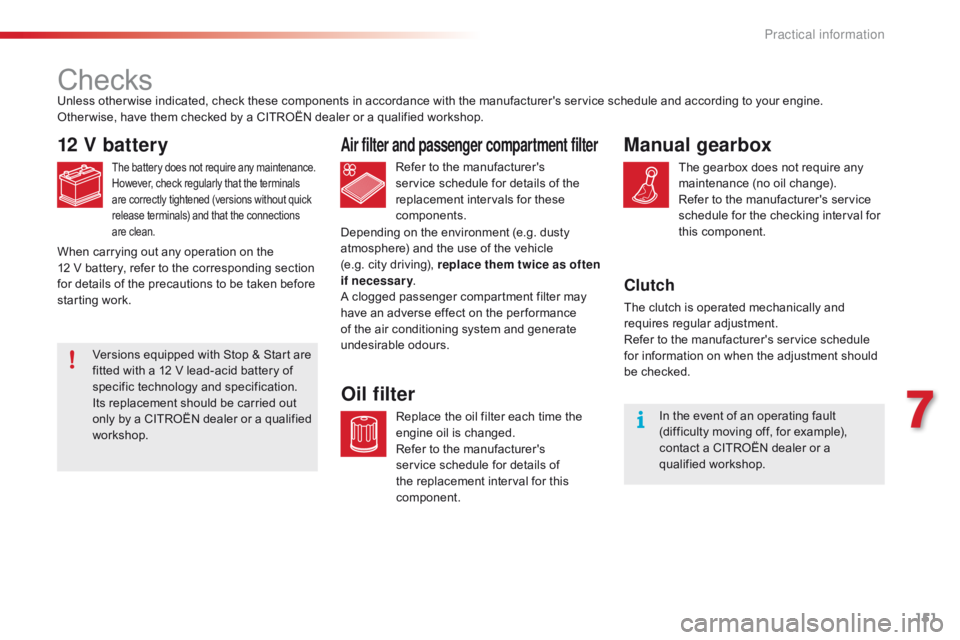
151
C1_en_Chap07_info-pratiques_ed01-2016
Checks
12 V battery
The battery does not require any maintenance.
H owever, check regularly that the terminals a
re correctly tightened (versions without quick
r
elease terminals) and that the connections
a
re clean.Refer to the manufacturer's service schedule for details of the
r
eplacement intervals for these
c
omponents.
Air filter and passenger compartment filter
Replace the oil filter each time the e ngine oil is changed.
Refer
to the manufacturer's
s
ervice schedule for details of
t
he replacement interval for this
c
omponent.
Oil filter
Unless other wise indicated, check these components in accordance with the manufacturer's service schedule and according to your engine.
O ther wise, have them checked by a CITROËN dealer or a qualified workshop.
Depending
on the environment (e.g. dusty
a
tmosphere) and the use of the vehicle
(e.g.
city driving), replace them twice as often
if necessary .
A
clogged passenger compartment filter may
h
ave an adverse effect on the per formance
o
f the air conditioning system and generate
u
ndesirable
o
dours.
When
carrying out any operation on the
12
V battery, refer to the corresponding section
f
or details of the precautions to be taken before
s
tarting work.
Manual gearbox
The gearbox does not require any maintenance (no oil change).
Refer
to the manufacturer's service
s
chedule for the checking interval for
t
his
c
omponent.
Clutch
The clutch is operated mechanically and requires r egular a djustment.
Refer
to the manufacturer's service schedule
f
or information on when the adjustment should
be c
hecked.In
the event of an operating fault
(
difficulty moving off, for example),
c
ontact a CITROËN dealer or a
q
ualified
w
orkshop.
Versions
equipped
with
Stop
&
Start
are
f
itted
with
a
12
V
lead-acid
battery
of
s
pecific
t
echnology
a
nd
s
pecification.
Its
replacement
should
be
carried
out
o
nly
by
a
CITROËN
dealer
or
a
qualified
w
orkshop.
7
Practical information
Page 154 of 269
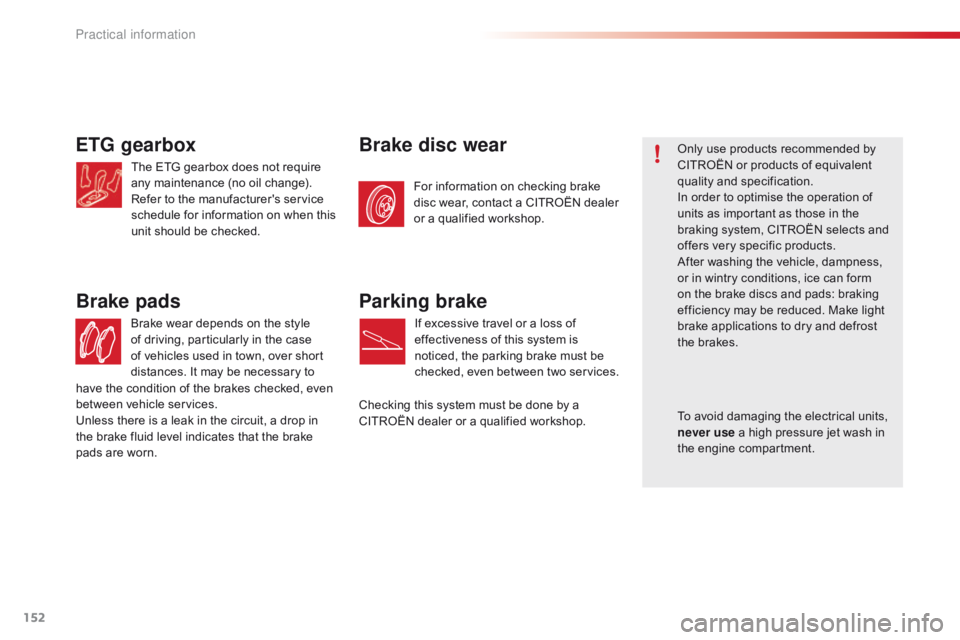
152
C1_en_Chap07_info-pratiques_ed01-2016
ETG gearbox
The ETG gearbox does not require any maintenance (no oil change).
Refer
to the manufacturer's service
s
chedule for information on when this
u
nit should be checked.
Brake
wear depends on the style
o
f driving, particularly in the case
o
f vehicles used in town, over short
d
istances. It may be necessary to
Brake pads
For information on checking brake disc wear, contact a CITROËN dealer
o
r a qualified workshop.
Brake disc wearOnly use products recommended by CITROËN or products of equivalent
q
uality
an
d
sp
ecification.
In
order to optimise the operation of
u
nits as important as those in the
b
raking system, CITROËN selects and
o
ffers very specific products.
After
washing the vehicle, dampness,
o
r in wintry conditions, ice can form
o
n the brake discs and pads: braking
e
fficiency may be reduced. Make light
b
rake applications to dry and defrost
t
he brakes.
Parking brake
If excessive travel or a loss of effectiveness of this system is
n
oticed, the parking brake must be
c
hecked,
e
ven
b
etween
t
wo services.
Checking
this system must be done by a
C
ITROËN
dealer or a qualified workshop.
have
the
condition
of
the
brakes
checked,
even
b
etween
v
ehicle
s
ervices.
Unless
there
is
a
leak
in
the
circuit,
a
drop
in
t
he
brake
fluid
level
indicates
that
the
brake
p
ads
are
worn. To
avoid damaging the electrical units,
n
ever use a high pressure jet wash in
t
he engine compartment.
Practical information
Page 179 of 269

177
C1_en_Chap08_en-cas-pannes_ed01-2016
12 V battery
The battery is located under the bonnet.
F or access to the (+) terminal:
F
r
elease the bonnet using the interior lever,
t
hen the exterior safety catch,
F
r
aise the bonnet and secure it with its stay,
F
l
ift the plastic cover for access to the
(+)
t
erminal.
Access to the battery
Procedure for starting the engine using another battery or charging a discharged battery.
Before doing any work
Immobilise the vehicle: apply the parking brake, put the gearbox in
n
eutral, then switch off the ignition.
Check
that all electrical equipment is
s
witched off.
The presence of this label, in particular
with
the
Stop
&
Start
system,
indicates
t
he
use
of
a
12
V
lead-acid
battery
with
s
pecial
t
echnology
a
nd
s
pecification;
t
he
involvement
of
a
CITROËN
dealer
o
r
a
qualified
workshop
is
essential
w
hen
replacing
or
disconnecting
the
b
attery. After
refitting the battery, the Stop & Start
s
ystem will only be active after a
c
ontinuous period of immobilisation of the
v
ehicle, a period which depends on the
c
limatic conditions and the state of charge
o
f the battery (up to about 8 hours).Do not push the vehicle to start the
engine
if you have an ETG electronic
g
earbox.
General points
Lead-acid starter batteries
Batteries contain harmful substances such as sulphuric acid and lead.
They
must be disposed of in
a
ccordance with regulations and must
n
ot, in any circumstances, be discarded
w
ith household waste.
Take
used remote control batteries and
v
ehicle batteries to a special collection
point. Protect
your eyes and face before h
andling the battery.
All
operations on the battery must be
c
arried out in a well ventilated area and
a
way from naked flames and sources
o
f sparks, so as to avoid the risk of
e
xplosion or fire.
Wash
your hands after wards.
8
In the event of a breakdown
Page 180 of 269
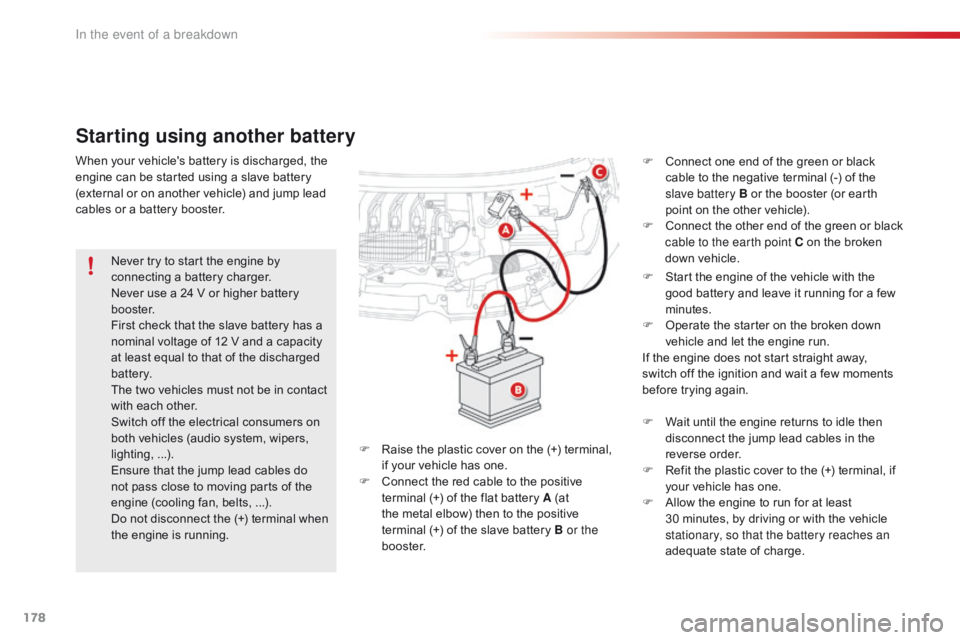
178
C1_en_Chap08_en-cas-pannes_ed01-2016
Starting using another battery
F Start the engine of the vehicle with the g
ood battery and leave it running for a few
m
inutes.
F
O
perate the starter on the broken down
v
ehicle and let the engine run.
If
the engine does not start straight away,
s
witch off the ignition and wait a few moments
b
efore trying again.
Never
try
to
start
the
engine
by
c
onnecting
a
battery
charger.
Never
use
a
24
V
or
higher
battery
b
o o s t e r.
First
check
that
the
slave
battery
has
a
n
ominal
voltage
of
12
V
and
a
capacity
a
t
least
equal
to
that
of
the
discharged
b
attery.
The
two
vehicles
must
not
be
in
contact
w
ith
each
other.
Switch
off
the
electrical
consumers
on
b
oth
vehicles
(audio
system,
wipers,
l
ighting,
...
).
Ensure
that
the
jump
lead
cables
do
n
ot
pass
close
to
moving
parts
of
the
e
ngine
(cooling
fan,
belts,
...).
Do
not
disconnect
the
(+)
terminal
when
t
he
engine
is
running. F
W
ait until the engine returns to idle then
d
isconnect the jump lead cables in the
r
everse
o
rder.
F
R
efit the plastic cover to the (+) terminal, if
y
our vehicle has one.
F
A
llow the engine to run for at least
3
0 minutes, by driving or with the vehicle
s
tationary, so that the battery reaches an
adequate
state of charge.
When
your
vehicle's
battery
is
discharged,
the
e
ngine
can
be
started
using
a
slave
battery
(
external
or
on
another
vehicle)
and
jump
lead
c
ables
or
a
battery
booster.
F
R
aise
the
plastic
cover
on
the
(+)
terminal,
i
f
your
vehicle
has
one.
F
C
onnect
the
red
cable
to
the
positive
t
erminal
(+)
of
the
flat
battery
A
(at
t
he
metal
elbow)
then
to
the
positive
t
erminal (+)
of
the
slave
battery
B or the
b o o s t e r. F
C
onnect one end of the green or black
c
able to the negative terminal (-) of the
s
lave battery B or the booster (or earth
p
oint on the other vehicle).
F
C
onnect
t
he
o
ther
e
nd
o
f
t
he
g
reen
o
r
b
lack
c
able to the earth point C on the broken
d
own vehicle.
In the event of a breakdown
Page 236 of 269

234
C1_en_Chap10a_ Autoradio-Toyota-tactile-1_ed01-2016
Settings, configuration
QUESTIONANSWER SOLUTION
There
is a difference in
s
ound
quality between the
d
ifferent audio sources
(
radio,
U
SB...). For
optimum sound quality, the audio settings (Volume, Treble,
M
edium, Bass) can be adapted to the different sound sources,
w
hich may result in audible differences when changing source
(
radio,
U
SB...). Check
that the audio settings are adapted to
t
he sources listened to. It is advisable to select
a
utomatic sound adjustment (Low, Medium,
Hig
h).
Check
the quality and format of your recording.
With
the engine off, the
s
ystem
switches off after a
f
ew
minutes of use. When
the engine is switched off, the system's operating time
d
epends on the battery charge.
The
switch-off is normal: the system changes to economy mode
a
nd switches off to preserve the state of charge of the vehicle's
b
attery. Start
the vehicle's engine to increase the battery
c
harge.
Audio and Telematics
Page 256 of 269
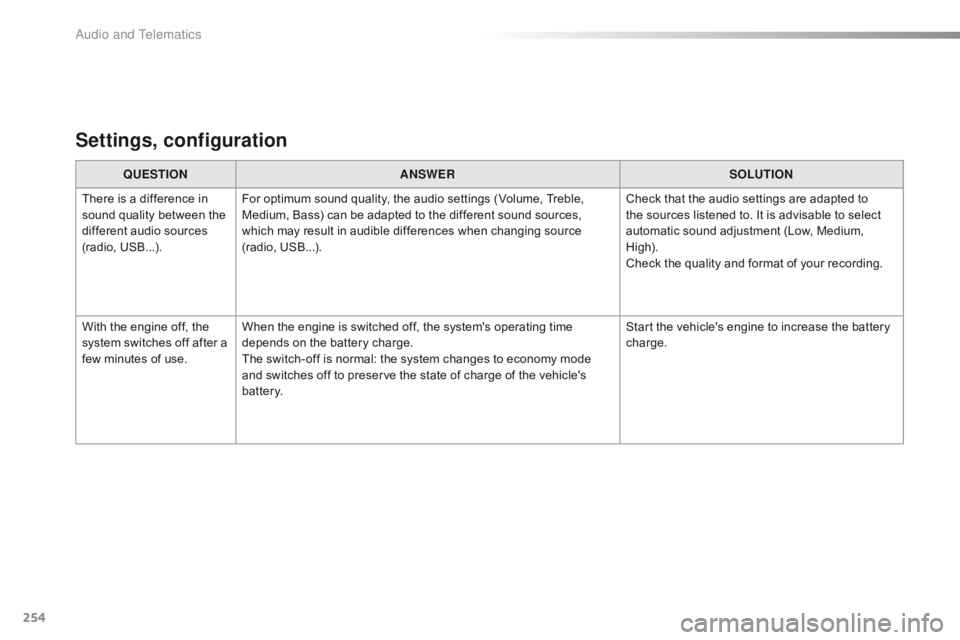
254
C1_en_Chap10b_ Autoradio-Toyota-2_ed01-2016
Settings, configuration
QUESTIONANSWER SOLUTION
There
is a difference in
s
ound
quality between the
d
ifferent audio sources
(
radio,
U
SB...). For
optimum sound quality, the audio settings (Volume, Treble,
M
edium, Bass) can be adapted to the different sound sources,
w
hich may result in audible differences when changing source
(
radio,
U
SB...). Check
that the audio settings are adapted to
t
he sources listened to. It is advisable to select
a
utomatic sound adjustment (Low, Medium,
Hig
h).
Check
the quality and format of your recording.
With
the engine off, the
s
ystem
switches off after a
f
ew
minutes of use. When
the engine is switched off, the system's operating time
d
epends on the battery charge.
The
switch-off is normal: the system changes to economy mode
a
nd switches off to preserve the state of charge of the vehicle's
b
attery. Start
the vehicle's engine to increase the battery
c
harge.
Audio and Telematics
Page 259 of 269
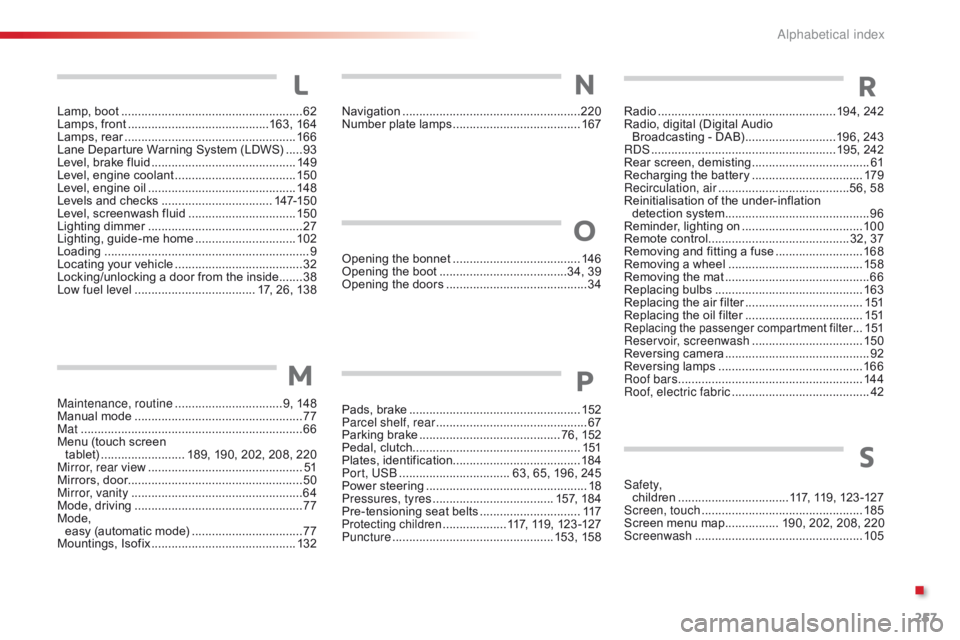
257
C1_en_Chap11_index-alpha_ed01-2016
Lamp, boot ......................................................62
Lamps, front .......................................... 16
3, 16 4
Lamps,
re
ar
...............................
....................166
Lane
Departure Warning System (LDWS)
.....93
L
evel, brake fluid
........................................... 14
9
Level,
engine coolant
.................................... 15
0
Level,
engine oil
...............................
.............148
Levels
and checks
..............................
...147-150
Level,
screenwash fluid
................................15
0
Lighting
dimmer
..............................
................27
Lighting,
guide-me home
..............................10
2
Loading
..............................
............................... 9
Locating
your vehicle
...................................... 32
L
ocking/unlocking a door from the inside.......38
Low fuel level
..............................
...... 17, 26, 138
Maintenance, routine
................................ 9
, 148
Manual
m
ode
.................................................. 77
M
at
.......
........................................................... 66
Menu
(touch screen
tablet)
...............
.......... 189, 190, 202, 208, 220
Mirror, rear view
.............................................. 51
M
irrors, door.................................................... 50
Mirror, vanity
..............................
.....................64
Mode,
driving
..............................
....................77
Mode,
easy
(automatic mode)
.................................77
M
ountings,
I
sofix
...............................
............132
L
M
Navigation ............................... ......................220
Number plate lamps ...................................... 16
7Radio ...............
......................................194, 242
Radio, digital (Digital Audio
Broadcasting
- DAB)
...........................1
96, 243
RDS
................
.......................................195, 242
Rear
s
creen,
d
emisting
...................................61
R
echarging the battery
.................................17
9
Recirculation, air
...............................
........56, 58
Reinitialisation
of the under-inflation
detection
system
...........................................96
R
eminder, lighting on
....................................10
0
Remote
control
..........................................3
2, 37
Removing
and fitting a fuse
..........................16
8
Removing
a wheel
..............................
..........15 8
Removing
the mat
...............................
............66
Replacing
bu
lbs
..............................
..............163
Replacing
the air filter
...................................1
51
Replacing
the oil filter
...................................1
51
Replacing the p assenger c ompartment f ilter ...151
Reservoir, screenwash ................................. 15
0
Reversing
c
amera
...............................
............ 92
Reversing
lam
ps
........................................... 16
6
Roof bars
....................................................... 14
4
Roof, electric fabric
......................................... 42
O
pening
the
bonnet
......................................
14
6
Opening
the
boot
..............................
........34,
39
Opening
the
doors
...............................
...........
34
Pads,
b
rake
................................................... 15
2
Parcel shelf, rear
............................................. 67
P
arking
brake
.......................................... 7
6,
152
Pedal,
clutch.................................................. 151
Plates,
id
entification ...................................... 18 4
Port, USB
................................. 6
3,
65,
196,
245
Power
s
teering
................................................ 18
P
ressures, tyres
.................................... 1
57,
184
Pre-tensioning
seat
belts
.............................. 11
7
Protecting children ...................1 17, 119, 123 -127
Puncture ................ ................................ 153, 15
8
O
P
NR
S
Safety, children .................................1 17, 119, 123 -127
Screen, touch
...............................
.................185
Screen
menu map
................ 1
90, 202, 208, 220
Screenwash
..............................
....................105
.
Alphabetical index